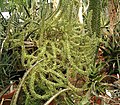|
Didiereaceae
Didiereaceae is a family of flowering plants found in continental Africa and Madagascar. It contains 20 species classified in three subfamilies and six genera. Species of the family are succulent plants, growing in sub-arid to arid habitats. Several are known as ornamental plants in specialist succulent collections. The subfamily Didiereoideae is endemic to the southwest of Madagascar, where the species are characteristic elements of the spiny thickets. SystematicsThe family was long considered entirely endemic to Madagascar until the genera Calyptrotheca, Ceraria, and Portulacaria from the African mainland were included.[2] Molecular phylogenetic analysis confirmed the monophyly of the family and its three subfamilies:[3]
The family is closely related to the New World family Cactaceae (cacti), sufficiently closely so that species of Didiereaceae can be grafted successfully on some cacti.[3] CalyptrothecoideaeContains only one genus, Calyptrotheca, with two species found in tropical East Africa.[3] DidiereoideaeThis subfamily is endemic to Madagascar, where it is found in the spiny thickets of the dry southwest. The plants are spiny succulent shrubs and trees from 2–20 m tall, with thick water-storing stems and leaves that are deciduous in the long dry season. All of the species except Alluaudiopsis have a distinct youth form. They start as small procumbent shrubs but eventually a dominant stem is produced that becomes a trunk. The trunk later branches forming a crown and the basal branches die off.[4] All species are dioecious (Decarya female-dioecious). The plants have different long-shoots and short-shoots (brachyblasts). Long-shoot leaves are soon deciduous, but brachyblasts form in the leaf axils and from them grow small leaves that appear singly or in pairs and are accompanied by conical spines (much like the areoles found in cacti). The flowers are unisexual (except from Decarya) and radially symmetric, made up of four tepals with two basal bracts. Flowers rarely occur singly. They usually develop in branched clusters that emerge instead of leaves from the brachyblasts.[4] There are four genera with eleven species:
Alluaudiopsis Humbert & Choux 1934
Key to the genera of Didieroideae:
PortulacarioideaeContains one genus, Portulacaria, with seven species, distributed in Southern Africa. Species formerly considered in the separate genus Ceraria are now included in Portulacaria.[3] Gallery
References
|
|||||||||||||||||||||||||||||||||||||||||||||||||||||||||






